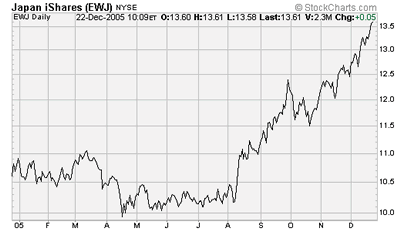| Home | About Us | Resources | Archive | Free Reports | Market Window |
Welcome to the JungleBy
Friday, December 23, 2005
In December 1974, gold made an all time high at $195 an ounce. Four years earlier, President Nixon had released gold from its peg at $35 an ounce. By the end of ’71, gold fetched $43 an ounce. By ’72, it had climbed to $64. U.S. citizens were still prohibited from owning gold, but the law didn’t stop gold rising to $106 by the end of 1973. By late 1974, gold was making headlines. Nixon had repealed gold’s prohibition. The New York Mercantile Exchange started promoting its first ever gold futures contract – to be launched on December 31st, 1974 - and the price of gold had passed $195 an ounce. Inflation was stirring. Here’s a headline from December 17th, 1974: “Ford administration still regards inflation, not recession, as a more serious economic problem,” said the CBS evening news. Gold investors must have been licking their chops. This is a cinch, they must have thought, gold cannot fall. Eighteen months later, gold was at $103 an ounce. A large number of investors got burned. It would be July 1978 before 1974’s all-time high would be regained. A bull market needs corrections to shake out the traders who lack conviction. It’s like pruning the rosebush. The strongest investors make the most money. Gold eventually hit $850 in January 1980. But would you have held through the bear market of 1975/76? “The market always destroys the weak,” says George Soros, “That is, investors who don’t have well founded convictions.” Gold’s rise from $235 to $500 has been a cakewalk for investors... even for those with a weak stomach. We’ve had no major corrections, nor any major bouts of pessimism to test our mettle. Even the ‘buy-the dips’ crowd’ has been making money... These traders like to buy whenever the price hits the lower wall of the trend channel and sell when it hits the upper wall. As a strategy, it’s worked very well for the last 5 years. Success breeds complacency. As a result: The idea of a 25% correction in gold – say from $540 to $400 - is now preposterous to most players. I believe we are in the early stages of a bull market in gold. In Thursday’s column, I reaffirmed my thoughts with an analysis of current sentiment in the gold market. “At the moment,” I wrote, “no one seems to agree on the reasons for gold’s rise. I like that. The press is confused. There’s little consensus.” No one in my family is interested in gold. No one talks about it at parties yet. If you subscribe to Steve’s newsletter, True Wealth, take a look at Steve’s recommended portfolio of safe, long-term plays. You’ll find a number of gold-related investments, including a position in rare U.S. gold coins. Steve owns gold. I do too. We plan to hold onto these investments for many years. That said, I think we’re in the process of a major correction in gold. “It’s been an easy ride so far,” I told Steve yesterday in an email, “welcome to the jungle.” On Wednesday, the latest issue of Fortune magazine arrived at our office. Gold was plastered all over the front cover. Two weeks ago, Barron’s had a four-figure gold price on their front cover. Optimism in the gold market is strong. And we saw a blow off price peak earlier this month. Today’s gold investors think gold cannot fall. Be warned... Here comes your first test. Gold could fall $50 an ounce or more. Have you got the stomach to hold on? You should. Welcome to the jungle, Tom Dyson Market NotesJAPAN : A FLOOD OF MONEY
|
It’s official: Japan is popular. As BusinessWeek recently reported:
Japan is also becoming a favorite recommendation of investment newsletters. In a recent article, newsletter tracker Mark Hulbert tells us the iShares MSCI Japan Index ETF (EWJ) is one of the most popular securities among investment newsletters. All this attention has pushed up the Nikkei Stock Average to five-year highs… and securities like EWJ are soaring. A one-year chart of the iShares MSCI Japan Index ETF (EWJ):
|
Recent Articles
|


